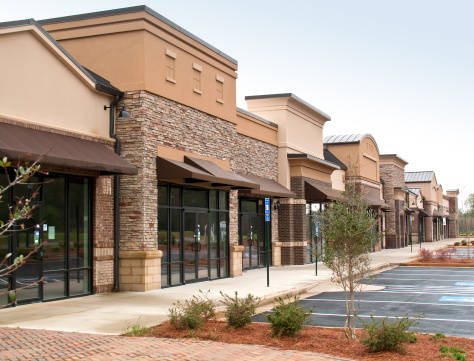For people across the globe, 2020 was a year unlike any other. The COVID-19 pandemic shook the financial foundations of societies everywhere, causing unprecedented and widespread economic fallout. But much like periods of economic turmoil in the past, while there were some who suffered, there were others who benefited from the shift in market trends.
In this 2020 Year in Review, we’ve identified the year’s winners and losers based on real estate asset classes and the broader real estate market. We also looked at some of the most important factors that could affect the real estate industry in 2021.
Asset Classes
Winners:
Multifamily
During the start of the COVID-19 pandemic, the multifamily industry was expected to be challenged by historic job losses around the country. However, the industry has outperformed other asset classes and lived up to its reputation of resiliency. The vast majority of tenants have continued to pay their rents even through the pandemic and apartment demand rebounded strongly in the third quarter.

The industry’s performance could be explained by a few factors. First, people always need a place to live, and many of those who could work remotely, chose to do so from the comfort of their homes. Second, the Coronavirus Aid, Relief, and Economic Security (CARES) Act gave relief aid to affected individuals and families, allowing them to meet financial obligations like rent through stimulus checks, extra unemployment benefits, and the Pay Check Protection program. Finally, the economy recovered enormously in the third quarter as businesses reopened and people returned to work.
Industrial
The industrial sector was hot prior to the COVID-19 pandemic, as the growth of e-commerce fueled demand for warehouse spaces and distribution centers. The pandemic made industrial properties even hotter, because local social distancing measures and “stay-at-home” policies suddenly forced many brick-and-mortar retailers and malls to close. Moreover, the competition between retailers to get products into consumers hands as quickly as possible through last-mile distribution heated up, further stimulating demand for smaller format “light industrial” warehouses strategically located closer to consumers. The pandemic also caused more shoppers to purchase groceries online, which increased demand for cold storage warehouses.
According to CBRE’s third quarter industrial report, the industrial sector is booming: net absorption was 56.8 million square feet in the quarter, compared to just under 50 million square feet in Q3 2019. Triple-net asking rents rose to $8.09 per square foot, up 6.4% from the third quarter in 2019, and vacancy remained low at 4.7%, and has only increased by 2 basis points during the pandemic. There’s 312.6 million square feet under construction, 38% of which is already preleased.
Self-storage
In general, moving is a growth factor for self-storage, which was labeled an essential business during the pandemic. And COVID-19 certainly caused a lot of relocation. There has been a 4% increase in moves (or more than 600,000 people) in 2020 compared to last year, according to media company MYMOVE’s analysis of United States Postal Service change-of-address data. At the onset of the outbreak, most were younger adults who moved in with family or friends after losing their jobs or to reduce the risk of contracting the virus. Additionally, people left dense cities for more secluded and spacious housing in the suburbs, and when the demand for suburban single-family homes spurred an increase in values, some seized the opportunity to sell and downsize.
Due to the relocating activity, the self-storage sector has resisted the financial fallout this year and posted stable occupancy and only slightly reduced revenues. During the pandemic, new self-storage demand also came from college students who suddenly needed a place to stash their belongings after campuses closed, and small business owners who needed to store their equipment and merchandise after closing their establishments abruptly. As a result, self-storage properties remained stable and cash flowing during the pandemic, and investor interest continued to be strong.
Losers:
Retail
Retail real estate was already hurting before 2020, and COVID-19 rubbed salt on its wounds. Brick-and-mortar retail sales are projected to plummet 14% for the year, heavily impacted by the closure of non-essential businesses in many cities and the rise of e-commerce.
 In its Q3 retail report, CBRE pointed out that retail had its lowest quarterly total for nationwide construction completions ever with just under 6 million square feet. Leasing activity was also down for the year and negative net absorption of 14.8 million square feet was the largest quarterly decline since the first quarter of 2009 during the Great Recession.
In its Q3 retail report, CBRE pointed out that retail had its lowest quarterly total for nationwide construction completions ever with just under 6 million square feet. Leasing activity was also down for the year and negative net absorption of 14.8 million square feet was the largest quarterly decline since the first quarter of 2009 during the Great Recession.
Approximately 10,000 retailers are expected to close nationwide this year as well as 15% – 17% of the country’s shopping malls, according to a Barclays report. The current owners of these malls and future proprietaries who will purchase them for discounts, are expected to convert the properties to other uses, such as medical clinics, schools, and industrial warehouses or fulfillment centers. Meanwhile, shuttered restaurants are becoming so called “ghost kitchens,” where food is prepared for delivery only.
Office
As workers were advised to stay at home, the pandemic brought remote working mainstream, drastically affecting the office real estate market.
Leasing activity plummeted in the second and third quarters of the year as did net absorption, and the vacancy rate rose to 14% from 12.3% in the first quarter, according to CBRE’s third quarter report. The negative net absorption of the second and third quarters was 54.9 million square feet, which eclipsed the 47.6 million square feet vacated during the entire Great Recession. Despite the decrease in demand, landlords are reluctant to reduce rents and are instead increasing concessions, the report indicated.
Companies are still allowing employees to work remotely, and many — especially those in the tech industry — plan to do so permanently. This trend is likely to continue long after the pandemic, according Cushman & Wakefield. The brokerage firm expects global office vacancy to continue to rise until 2022 and the number of people working from home to double in the next five years.
Hotels
The hospitality industry has probably been the hardest hit during the COVID-19 pandemic. Traveling for leisure and business halted when the outbreak began, devastating hotels. Many hotels were transformed into temporary hospitals to treat COVID-19 patients and others into housing for the homeless.
As occupancies fell, hotel revenues around the country plummeted. Chains of all sizes have either shuttered or utilized cost savings measures, such as furloughing employees and salary cuts. Occupancy fell 37.9% year over year in the third quarter, according to CBRE. Year-over-year investment volume in the third quarter was down 81% to $2.1 billion.
Hotel demand has been rising since April, although it has yet to return to pre-pandemic levels, according to a report by Koddi, which tracks hotel searches. Operators have had to put a focus on cleaning and sanitizing rooms and common areas to make guests feel comfortable. However, experts believe there is still a wave of hotels that will close before the sector recovers, which hotel industry data and analytics provider STR predicts will occur in 2023.
Capital Markets
Winners:
Multifamily Agency Lenders and Borrowers
After the pandemic caused widespread financial uncertainty, banks tightened lending standards and more thoroughly scrutinized borrowers, especially those in the aforementioned bruised office, hotel and retail sectors.
However, the Federal Reserve lowered interest rates to historically low levels, triggering soaring demand for refinancings. Well-capitalized borrowers have been able to lock in loans with historically low rates, some in the mid-2% range. Additionally, the Fed has expressed that it will continue to hold interest rates near zero until 2023, which is likely to continue to keep mortgage rates low.
Most of the refinances occurred on multifamily properties and through agency lenders, which issue loans securitized by government-sponsored enterprises Freddie Mac and Fannie Mae. Lenders were focusing on properties that continued to have high occupancy and collections through the pandemic, and multifamily fit the bill as occupancy rates and collections generally remained stable. Freddie and Fannie had higher earnings in the third quarter due to the refinance boom.
Losers:
CLO and CMBS issuers
Highly leveraged real estate companies that use repurchase (repo) agreements to buy mortgages and issue non-agency collateralized loan obligations (CLOs) and commercial mortgage-backed securities (CMBS), which are bonds backed by pools of mortgages on commercial properties, faced a liquidity crisis this year. The effects of the pandemic suddenly depreciated their assets, especially retail- and hotel-backed loans, and repo lenders instituted margin calls. This forced some issuers to sell debt at steep discounts.
The Fed was forced to step in to support the credit market with a new version of the Term Asset Backed-Securities Loan Facility (TALF) program it used during the Great Recession. The program injected liquidity back into the market by purchasing loans, including commercial real estate CLOs and CMBS.
CMBS Investors
Interest in CMBS issuance decreased this year, and only $44.5 billion has been issued by early October, $14.2 billion less than by the same period in 2019. CMBS issuance is expected to be between $53 billion and $55 billion for the entire year, the lowest total since 2012. Last year, approximately $100 billion in CMBS loans were issued.
CMBS investors, which are typically pension funds, banks, insurance companies and mutual funds, experienced some discomfort during the pandemic, as delinquencies on hotels, regional malls and other retail spaces rose. After 12 consecutive months of declines, the Fitch Rating’s U.S. CMBS delinquency rate increased in April. At that time, the rate rose just one basis point to 1.32%, which represented 383 loans worth $6.2 billion. However, as the pandemic continued, delinquencies increased dramatically across the country in commercial properties. The rate of CMBS delinquencies was 4.85% as of October, representing more than 1,028 loans and $23 billion, according to Fitch.
The overall rate of CMBS delinquencies would have been even higher, had it not been for government stimulus, and debt relief by servicers and Freddie Mac, the Fitch report indicated. Over $17.3 billion, or approximately 600 loans, have been granted debt relief, and only 5% of those have become 60 days or more delinquent, according to Fitch.
Major Cities
Extremely dense major cities with high taxes and high cost of living are experiencing an exodus as people are moving away in droves to less dense cities with lower expenses and taxes, and more spacious housing. The main drivers have been the rise of remote working, and the shuttering of businesses and entertainment venues, which were the main highlights of big cities. It has allowed employees to choose to live in more affordable areas while working for employers in dense urban areas.
 According to the results of a survey by freelancing platform Upwork, between 14 million and 23 million Americans are planning to relocate for remote working opportunities. The survey found most migrants are leaving from major cities, nearly 53% are planning to move to a house that is more affordable, and approximately 55% are moving to a location at least more than two hours away. In terms of specific regions, people are heading to the Sun Belt region, which refers to the states from California to North Carolina. This trend began pre-COVID-19 due to those states having lower tax burdens and cost of living expenses, and warmer climates, and has been accelerated due to the pandemic.
According to the results of a survey by freelancing platform Upwork, between 14 million and 23 million Americans are planning to relocate for remote working opportunities. The survey found most migrants are leaving from major cities, nearly 53% are planning to move to a house that is more affordable, and approximately 55% are moving to a location at least more than two hours away. In terms of specific regions, people are heading to the Sun Belt region, which refers to the states from California to North Carolina. This trend began pre-COVID-19 due to those states having lower tax burdens and cost of living expenses, and warmer climates, and has been accelerated due to the pandemic.
2021 Outlook
From the coronavirus to new political policies, a variety of factors may impact the real estate industry next year. While it is impossible to exactly know how things will play out, we are optimistic that the worst is behind us, and here’s why.
After a turbulent year, there appears to be a light at the end of the tunnel regarding the virus. COVID-19 vaccine testing has shown extremely promising early results, and experts are hopeful that there could be a mass distribution by the spring of 2021.
President-elect Joe Biden will officially take the reins of the White House in January, and Congress is expected to pass another stimulus package, which could potentially be a boon for the multifamily industry. The scope of the new stimulus is difficult to predict though, because two close runoff elections in Georgia will occur in January and could potentially decide which party controls the U.S. Senate.
There are some potential headwinds, such as Biden’s tax reform plans, which may impact various real estate tax benefits. Additionally, the controversial national moratoriums on evictions and foreclosures that expires on New Year’s Eve may be further extended under the Biden administration.
However, other potential tailwinds include mortgage interest rates are likely to continue to stay historically lower as the Fed plans to keep interest rates low to allow inflation to rise, and experts expect the U.S. gross domestic product will return to pre-pandemic levels next year.
In Conclusion
The COVID-19 pandemic dominated this year from almost beginning to end, creating heightened uncertainty as investors struggled to navigate an unprecedented economic environment.
What became evident was that the pandemic accelerated budding real estate trends in various markets and asset classes. For example, the migration away from dense, high cost of living, highly taxed urban areas to spacious and low cost of living cities and suburbs had already begun, but increased due to the outbreak. It was helped by another emerging trend: remote working, which also rose to prominence as residents became untethered from their workplaces. The adoption of e-commerce quickened as well, as consumers moved further away from brick-and-mortar retailers under social distancing guidelines, and demand for last-mile delivery centers grew to satisfy the need for faster shipping times.
These trends and more have affected real estate strategies during the pandemic. Whether those trends are temporary or will become the norm in a post COVID-19 world remains to be seen.
